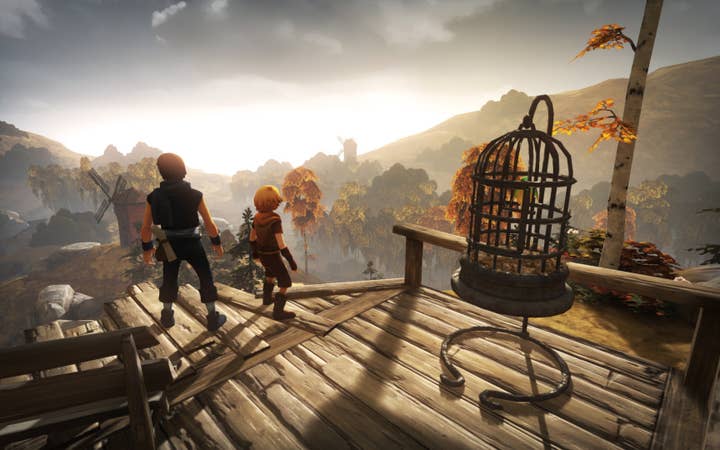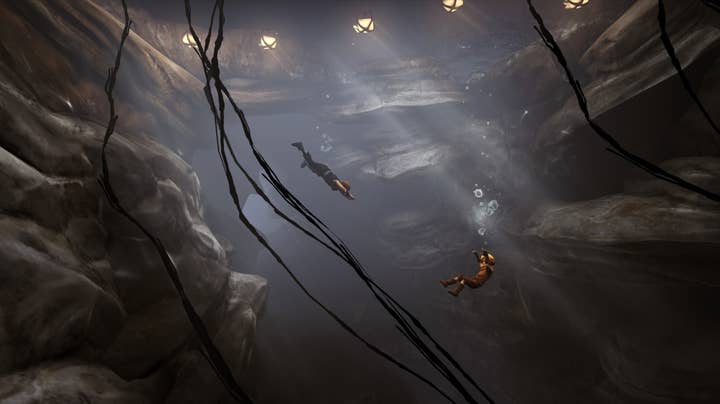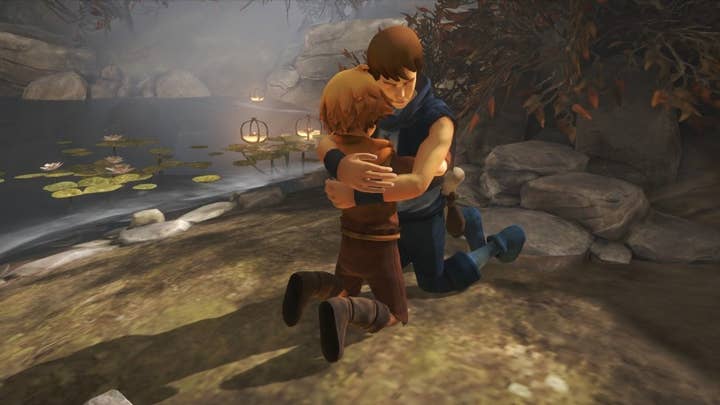Brothers: A Tale of Two Sons | Why I Love
Distant Bloom game director Cruz Segovia Ardiz dives into how the 2013 adventure evoked emotions through gameplay
Why I Love is a series of guest editorials on GamesIndustry.biz intended to showcase the ways in which game developers appreciate each other's work. This entry was contributed by Ember Trail's Cruz Segovia Ardiz, game director of the alien planet management game Distant Bloom, which launched on Steam last week.
I was barely a teenager when I played Metal Gear Solid for the first time on my brand-new PlayStation console. The whole experience was exhilarating, but what truly left a mark on me, like for many others, was the encounter with Psycho Mantis. For those who might not remember this boss fight: to defeat this mind-reading enemy, who could predict all your movements, you had to physically disconnect your controller and plug it into the Player 2 slot controller, so that Psycho Mantis could not read your mind anymore, allowing you to finally defeat him.
Back then, I did not fully understand why I found this feature so mind-blowing. For a while, I just thought of it as a great example of breaking the fourth wall. However, while Metal Gear Solid had many other instances of breaking the fourth wall, mostly through dialogues or in cutscenes, none felt as impactful to me as that one boss fight mechanic.
A few years had to pass-by for me to fully understand what had happened there or why certain narrative solutions just felt more powerful to me as a player and the game that finally made it all click was Brothers: A Tale of Two Sons.
Brothers, developed by Starbreeze Studios and released back in 2013, is arguably one of the pinnacles of this kind of storytelling through wordless, moment-to-moment gameplay mechanics, for me as a player and specially as a wannabe Game Designer. It was one of the first games I felt like playing with a notebook nearby, so I could write down and analyse how it was all built as I tried to discover how the team was capable of achieving such a meaningful narrative and such deep connection between the two brothers, without writing dialogue or a single line of text.

Breaking the mental model
Let’s start with the basic controls of the game. This game features a unique mechanic, putting players in control of two brothers simultaneously, each assigned to a different thumbstick on the controller. This unique control scheme not only fosters a powerful sense of connection between the two main characters but also actively immerses players in their journey. This way to handle character controls in a game surely feels awkward when you start playing, even uncomfortable and goes against standard mental models for the player which is a dangerous thing to do for your game as any UX expert will tell you. However slowly but steadily, the game succeeds in making this mechanic feel more intuitive and comfortable as the adventure progresses.
In this particular case, breaking the mental model and forcing the player to re-learn how the basic controls work is a masterful gambit that has a powerful impact in the narrative as we will see later on and it uses a similar concept to the “backwards bicycle” principle, but more on this later.
All gameplay is narrative
From the title screen, Brothers sets a dark tone, hinting at themes of loss and grief. The intro cutscene, depicting the death of the protagonists' mother, seamlessly integrates narrative with a key gameplay mechanic we will discover a few moments later: the little brother won’t be able to cross any body of water alone or without holding on to his big brother and if at any point you, as the player, let go of the brother in one of these sections, the little kid will drown, resulting in Game Over. The fear of water, stemming from the traumatic event of his mother’s death, becomes a recurring gameplay mechanic, driving home the emotional weight of loss and at the same time the dependency between the two brothers.
Throughout the journey, without dialogue or text, interactions with NPCs and the environment reveal the brothers' personalities. The older brother exudes maturity and protection, while the younger one displays mischief and curiosity. These interactions not only establish different roles but also delve deeper into their personalities, shaping the narrative through proactive interaction with the world around us.

The "backwards bicycle" principle
We have seen just a few of the elements the game uses to create a strong narrative without using any standard narrative devices, however, it is the game's heartbreaking finale that truly highlights the power of word-less narrative. Without spoiling too much, the game strips away one of the brothers, leaving players to navigate the world with just a single character. This “simple” change in mechanics transforms the gameplay experience at the end of the game into a poignant exploration of loss and loneliness and has a massive emotional impact for any player invested in the story and the relation between the characters.
The feeling of loss in this example is mechanically transmitted to the player through the loss of function of one of the thumbsticks that, by now, they are finally used to controlling. This means that every time you as a player intuitively reach out to the second, now inert, thumbstick you will feel this loss, not just as the character itself but also as a player, it will feel like a part of you disappeared, and for the rest of the game, you will keep experiencing this kind of phantom-limb syndrome.
And this is the most interesting part, through breaking the mental model and forcing players to spend hours re-learning an unusual control scheme, they will be subconsciously primed to develop a stronger than usual bond between the players themselves and the characters. When you suddenly remove one of the brothers from the equation, you leave the player with a strange feeling of loss that could have never been transmitted in the same way by standard narrative devices.
Good times ahead for word-less narratives
Brothers: A Tale of Two Sons, together with games like Journey, Limbo or earlier on Shadow of The Colossus are a few of the games that proved that you could create deep and meaningful narratives and evoke strong emotions in the player without having to write a single word.
Luckily, it seems like we won’t have a shortage of developers pushing this medium, from Daniel Mullins' mind-bending narratives to Davey Wreden's existential musings, or the dread-infused worlds from David Szymanski, in addition to the birth and growth of emergent narratives that are becoming extremely popular among players. Either through online shared gameplay (Among Us, Lethal Company, Phasmophobia) or procedurally created ecosystems (Rimworld, Caves of Qud, Dwarf Fortress), there seem to be a healthy number of creators out there crafting wonderful and unique experiences with immersive narratives that focus on provoking emotions through the playable elements of their games as well as other, more classical storytelling tools.
In conclusion, word-less narrative and gameplay mechanics offer a unique avenue for emotional expression and world-building in video games. By leveraging the interactivity of the medium, developers can craft experiences that resonate deeply with players long after the credits roll. As we continue to explore the vast possibilities of interactive storytelling, one thing remains clear – sometimes, the most profound stories are the ones left unspoken.
Developers interested in contributing their own Why I Love column are encouraged to reach out to us at news@gamesindustry.biz.








